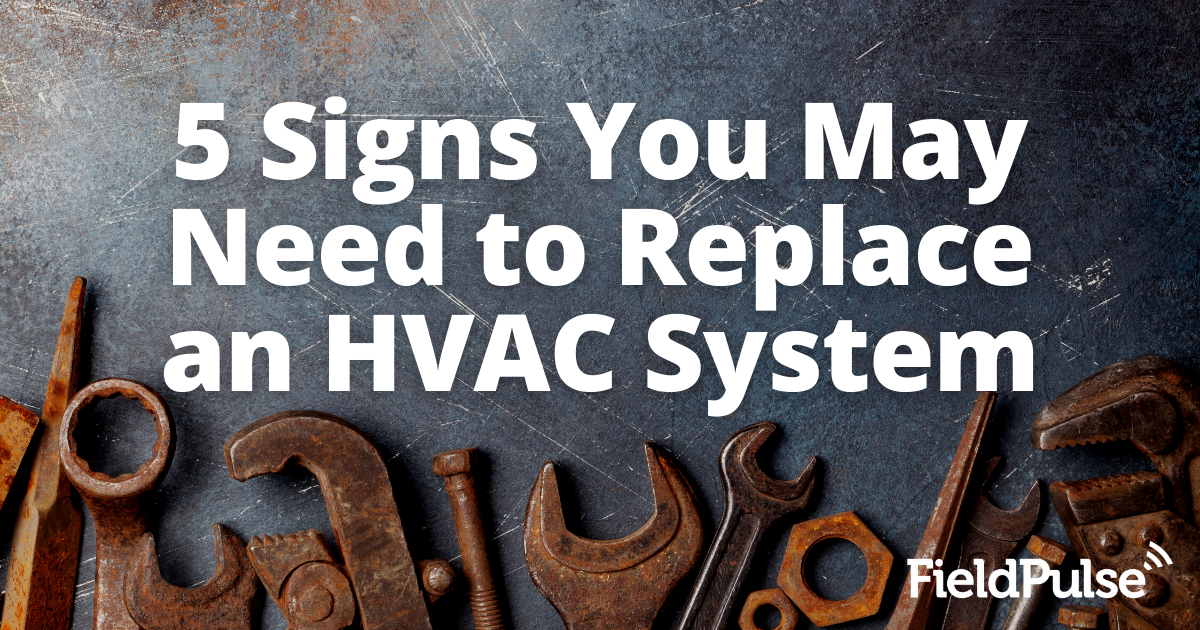As a seasoned HVAC professional, your clients depend on you to make the tough calls. After all, your knowledge and expertise can help homeowners save money, maintain a comfortable home, and keep their family safe during the hottest summer or coldest winter months. So, what do you do when you discover that you need to replace the HVAC system during a routine HVAC maintenance?
HVAC replacement costs are considerably higher than the occasional repair or HVAC checkup. However, when repairs start adding up, or the system is too old and too expensive to operate, it may be time to replace it. Below, we look at five signs you may need to replace an HVAC system.
Too Many HVAC Repairs
If the same client keeps calling you back to repair their HVAC system, they may be wasting their time and money on an old or damaged unit. The average cost of HVAC repair is $250 per visit, so if you’re making more than two visits per year to a single client, they pay too much for repair. This might be the time for you to recommend a full HVAC replacement.
One way to determine if repairs are too costly is to use the $5,000 rule. Take the age of the unit and multiply it by the amount of the repair. For example, the cost of your last repair on a six-year-old unit was 500 dollars. Multiplied together, the total is $3,000, which is less than $5,000. So, it may be worth it to repair the HVAC instead of replacing it. If the total is greater than 5,000 dollars, you should recommend replacing the unit instead of repairing it.
Noisy HVAC System
There are numerous reasons why an HVAC system may be noisy.
- Humming – loose parts (fan blades, pipes, etc.)
- Rattling – debris somewhere in the system
- Hissing – air leak in the ducts
- Loud screaming – a refrigerant leak or high pressure
- Clicking – damaged or worn capacitor
While many of these problems are not enough to warrant a full HVAC replacement, they can compound over time, weakening multiple components within the system. For this reason, you should stress the importance of routine HVAC maintenance. A regular inspection can help you identify these problems as they arise and help your customer save money.
Older HVAC System
Most HVAC systems last up to 15 years. However, most HVAC systems come with a limited warranty that lasts up to 10 years. Why the difference? After ten years, the system starts slowly breaking down. The warranty no longer covers repairs as they become more frequent and expensive. It’s only a matter of time before the homeowner needs a new heating and cooling system.
One of the first things you need to find out when discussing the homeowner’s problem is the HVAC system’s age. Any product over ten years old is instantly a candidate for replacement. AC units that are more than ten years old use a refrigerant known as R-22. This type of freon is outdated and harmful to the environment. Upgrading to a newer unit will help reduce your carbon footprint!
High Energy Bills
Americans pay an average of $117.00 for electricity. Heating and cooling the home is responsible for nearly 50 percent of the bill. If a homeowner notices a sharp increase in their electric bill, the best explanation is that the HVAC is old or heavily damaged and no longer operating efficiently. While repairs or regular HVAC maintenance may improve the system’s efficiency somewhat, the electric bill will probably keep climbing.
When meeting with a homeowner, you may be able to analyze their high electric bills to determine if the heating and cooling system is the cause. If so, a replacement can save them some money each month. While it is true that it takes more than ten years for a new HVAC to pay for itself, lower electric bills are always beneficial.
No Climate Control
While AC wars are a given in any family, the reason for everyone’s discomfort may not be personal preference. Instead, it could be that they are having difficulty maintaining a comfortable temperature throughout the house. Poor temperature control may be caused by a variety of issues such as
- Damaged thermostat
- Inaccurate thermostat
- Low fluid levels
- Clogged filters
- Cracked ducts
- Severe motor damage
Poor temperature control may indicate that the HVAC system is not powerful enough to distribute air throughout the home. If this is the case, the system will run non-stop but fail to warm or cool the house adequately. As a result, the homeowners are never comfortable but paying high electric bills. You may want to recommend replacing the old system with one that is designed to fit the house.
Upgrade Your Trade with FieldPulse
FieldPulse’s home service business software is the tool to help field service owners upgrade their trade.
With FieldPulse, you’ll have everything you need to run your business and manage your organization — all with industry-leading customer service and support. Contact FieldPulse today to schedule a free demo.


